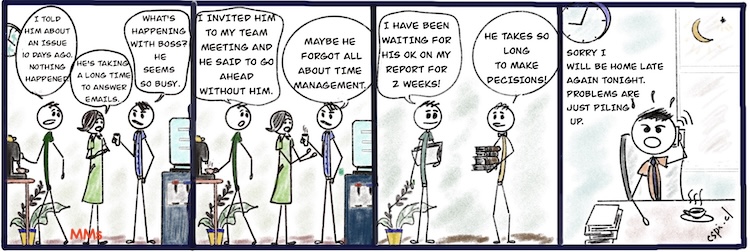No miracle occurs when you become a manager. You do not suddenly acquire amazing problem solving powers!
And yet, it is tempting , as a manger, to see yourself as the problem-solver-in-chief.
As a Middle Manager you will always be aware of problems that need to be resolved. In fact, you are accountable for dealing with problems in your area of accountability.

Problem Magnet
If you think that you are responsible for SOLVNG all the problems in your area, people will quickly be conditioned to know that they can take a problem to you and leave it with you to be resolved. In this way you become a problem magnet.
Back in 1974 the Harvard Business Review published an article which became the most requested reprint ever. It was entitled: Management Time. Who’s got the monkey? by William Oncken Jr and Donald L. Wass.
It addresses the challenge of being a problem magnet.
The monkey in the article is a metaphor for a problem. If the monkey is on your back then you have to care for it and feed it.

A manager was standing looking out the window of his office and watching his employees getting i their cars and driving off home while he was in his office with many chattering monkeys needing feeding! He decided that something needed to be done!
Where do the monkeys come from?
As a middle manager you will know that problems often find their way to your desk.
A direct report will tell you of a problem.
A casual meeting in the hall will have someone mention an issue.
A peer will drop off a report and ask for your input.
Something will just go wrong. A machine breakdown, a customer service failure, extreme weather, supply chain let down, employee error.
There are so may ways that, through meetings, emails, calls, texts or chance encounters, problems enter your space. Chattering monkeys seem to be all around. In the metaphor stopping the chatter is referred to as feeding the monkeys.
Standing looking out his window overlooking the parking area made him realize that he had taken. on the responsibility for feeding too many monkeys.
Getting rid of the monkeys
Let’s look at three scenarios to see how the monkeys jump onto your back.
1. A direct report tells you of a problem and you say “leave it with me I will look into it”. See the monkey jump from the direct report’s shoulder to yours? The monkey is now yours to feed.
2. A peer sends you a draft report and asks for your comments. You say Ok leave it with me I will look at this weekend”. Monkey jumped with glee onto your shoulder and immediately started chattering away.
3. A direct report gives you some completed work (presentation, Excel sheet, report on customer call) and at first glance you see that it is not well done. So you say to yourself “ I better go through this and make changes or I better check the formulas used in the Excel sheet as it seems wrong, I will call the client. In every case the monkeys leap onto you like young kids seeing Santa Claus enter.

So how can you stop this feeding frenzy? There are a number of possible changes:
Change One is to see the difference between ensuring that a problem is solved and solving it yourself. Another way of looking at it is to see the monkey on the shoulder of the person talking to you and ensuring that it stays there.
Change Two is to let your staff know that if they bring you a problem you expect them to have thought about how it might be solved. In other words you want them to tell you the problem AND how they think it might be solved.
This has three benefits.
First as the person with the monkey thinks about the problem, they might come up with a solution that they can implement and never have to introduce the monkey to you.
Second, If you are presented with the problem and the possible solutions, you might be able to select one and say “I agree with your solution #2. Go ahead with that!” See the monkey remain on the back of the direct report as they leave?
Third the focus of the conversation changes from being about the problem and more on how to solve it. This joint problem solving discussion is often a development step for the direct report.
Change Three: Reviewing drafts of anything can be time consuming. And there are times when it is essential – think contracts and important presentations or reports.
What is needed in reviewing is another pair of eyes which can often pick up on things that might have been missed or are unnecessary or are plain wrong.
I recommend doing the review with the author present. What might happen:
– If you see errors in grammar and spelling – tell them to check the whole document for these errors thus freeing you up from reading every word.
– If something is missing, this can be discussed and the author will need to add it.
– If something appears wrong the author is asked to check it.
– The same with unnecessary data or words. The author gets to correct it.
By the time the review is complete the author is leaving with the monkeys speaking into his/her ears.
Imagine if you were to read it at home late at night, or in your office after hours. You now have to make copious notes, then you have to explain them to the author in an email or in the margins of the document. That is monkey feeding at its best.

Change four: Problems arriving in your inbox. These are sneaky because the author of the email secretly sends you a monkey to feed. They can say “well I emailed the boss. I will wait for his/her reply”.
You read the email. See it is a problem and add it to your todo’s for follow up. Monkey accepted and needs feeding.
What to do instead? See it as a boomerang. Send an email back which says “I understand the problem. What are your suggestions for resolving it? Please talk to me re this when you have thought through the alternatives.”
Boom – monkey gone off your shoulders and onto the author’s.
Change Five: There are some monkeys you want to feed. Do this selectively. As a middle manager you are achieving results through others and most of the time they will be able to handle the problems, albeit with some direction. If you do select a problem to resolve yourself, involve others who are impacted so that, while you may do the heavy, deep thinking and decision-making regarding solutions, they are part of it and learning from the experience.

